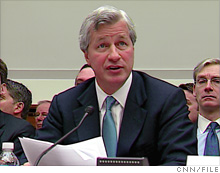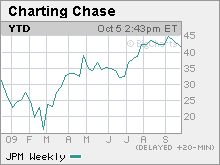Sizing up Jamie Dimon's next move
The JPMorgan Chase CEO has made many big deals, but analysts think the shopping spree may be over. So how will Dimon keep growing the bank?
 |
| JPMorgan Chase chief Jamie Dimon testifying before Congress earlier this year. |
 |
| JPMorgan shares, like many financial stocks, have recovered nicely since their March lows. |
NEW YORK (CNNMoney.com) -- When you've enjoyed the type of success that JPMorgan Chase chief executive officer Jamie Dimon has recently, delivering an encore performance is not going to be easy.
Last year, Dimon was the toast of Wall Street after pulling off the purchases of Bear Stearns and Washington Mutual at bargain basement prices within the span of just 6 months.
Shareholders, as a result, enjoyed some of the biggest returns within the industry, with JPMorgan Chase (JPM, Fortune 500) stock gaining roughly 9% since Lehman Brothers collapsed last fall. That's easily outpaced the performance of key rivals such as Citigroup (C, Fortune 500) and Bank of America (BAC, Fortune 500). Both of those stocks are still well below the prices they traded at a year ago.
Lately though, the New York City-based bank has indicated it is preparing for life without Dimon.
Last week, JPMorgan announced a series of high-profile management moves, including the appointment of Jes Staley to head the firm's investment banking division. Many who follow the bank closely believe that this could mean Staley will one day take over as chief executive.
"With the credit crisis largely behind us and the economy recovering, the timing was right to begin the succession process," Dimon said in a statement.
Analysts downplay the notion of an imminent departure by Dimon, though. Rather, many wonder just what the 53-year-old CEO plans to do next in order to satisfy shareholders and keep JPMorgan growing .
Douglas Penn, head of the U.S. financial institutions research group at RCM Capital Management, said one priority is returning the bank's profitability to pre-crisis levels.
Even as Dimon earned kudos for keeping the company in the black for the past year, earnings are significantly lower than they were before the credit markets first started to unravel in the summer of 2007.
JPMorgan is expected to report a third quarter profit of $1.8 billion, or 48 cents a share, when it releases its third-quarter results on Oct. 14. But in the third quarter of 2007, net income topped $2.9 billion, or 86 cents a share.
"It would make more sense [for Dimon to leave] when the bank is generating stronger earnings," said Penn.
As with many banks, rising credit losses have taken a severe bite out of JPMorgan's recent results, as the company has tried to cope with such factors as a rising unemployment rate.
Unfortunately, there is no indication that losses tied to consumer-related portfolios such as home equity loans and credit cards will ebb anytime soon.
In a presentation delivered to investors last month, Mike Cavanagh, the company's chief financial officer, warned that card charge-offs would likely approach 10% in the third quarter.
Since shoring up the bank's balance sheet will almost certainly be a focus for Dimon, analysts think that he is far less likely to undertake any other major acquisitions.
JPMorgan's retail banking business, for example, expanded dramatically last year after it scooped up WaMu for just $1.9 billion from the FDIC after that Seattle-based thrift became the largest bank to fail ever
But the stunning purchase may have also limited other ambitions the company may have once had. Nowadays, there are few U.S. geographic regions left unexplored by the bank. The company is also flirting with federal deposit limits of 10%.
Even buying a small regional lender in a key market might not even be worth the effort, notes Douglas Ciocca, a managing director at Renaissance Financial, which has about $1.8 billion assets under management, and owns JPMorgan shares.
"It could become too much of a micro-management challenge to integrate into the empire," Ciocca said.
Some analysts are also wary that the bank will be able to hold onto the lead it has established in some key Wall Street businesses in the wake of the Bear Stearns purchase. During the first nine months of this year, the company took the top spot in stock underwriting activity, according to research firm Dealogic.
But as more established players such as Goldman Sachs (GS, Fortune 500) and Morgan Stanley (MS, Fortune 500) recover and boutique shops continue to scrap for business left behind by the disappearance of Lehman Brothers, analysts warn that JPMorgan's stay at the top could prove short-lived.
As a result, there have been signs lately that the company is looking to other parts of its business to grow.
In recent months, the company has announced the expansion of several of its overseas operations, particularly in Asia, as part of a $1 billion program aimed at boosting its global presence.
At the same time, the company has enacted several major initiatives within its credit card division, unveiling such new products as its Sapphire and Slate cards, both of which are geared for more affluent consumers.
"They view this as a pretty opportune time to make some strategic investments in new products and to steal [market] share from others," said John Grund, a partner at the consultancy First Annapolis, which focuses on the card industry. "It is a very conscious, deliberate strategy."
Some analysts also speculate that Dimon could push the firm to bulk up the bank's asset management division.
Even as profits within that division have waned during the first half of this year, the business has grown increasingly attractive to Wall Street firms given its more stable source of revenue.
Complicating such growth plans, however, is the continued threat of more regulatory reform, including the hot-button issue of "too big to fail."
As the nation's second-largest bank with just over $2 trillion in assets, JPMorgan would probably be scrutinized should the issue gain momentum among lawmakers as they tackle reforming the financial system.
Speaking at the Clinton Global Initiative conference last month, Dimon said that the "too big to fail" issue needed to be resolved, but stopped short of suggesting that his bank needed to be broken up.
"By that I don't mean make the banks smaller," he said, according to a Bloomberg report. "We're large because we have a reason to be large." ![]()



